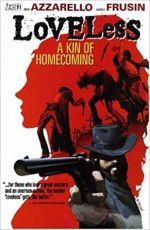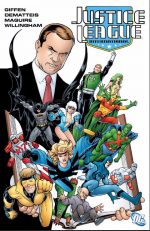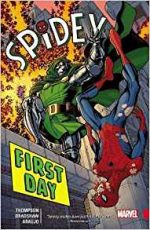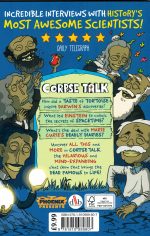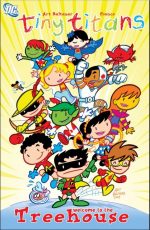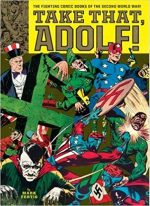
By J.-C. Méziéres & P. Christin with colours by E. Tranlé and translated by Jerome Saincantin (Cinebook)
ISBN: 978-1-84918-356-7
Val̩rian is arguably the most influential pictorial science fiction series ever published Рand yes, I am including both Buck Rogers and Flash Gordon in that expansive and undoubtedly contentious statement.
Although to a large extent those venerable newspaper strips formed the medium itself, anybody who has seen a Star Wars movie has seen some of Jean-Claude Méziéres & Pierre Christin’s brilliant imaginings which the filmic phenomenon has shamelessly plundered for decades: everything from the look of the Millennium Falcon to Leia’s Slave Girl outfit…
Simply put, more carbon-based lifeforms have experienced and marvelled at the uniquely innovative, grungy, lived-in tech realism and light-hearted swashbuckling roller-coasting of Méziéres & Christin than any other cartoon spacer ever imagined possible.
Valérian: Spatio-Temporal Agent launched in the November 9th 1967 edition of Pilote (#420, running until February 15th 1968). Although it was a huge hit, graphic album compilations only began with second tale The City of Shifting Waters, as all concerned considered the first yarn as a work-in-progress and not quite up to a preferred standard.
You can judge for yourself, by getting hold of the previous hardcover compilation volume…
The groundbreaking series followed a Franco-Belgian mini-boom in science fiction triggered by Jean-Claude Forest’s 1962 creation Barbarella. Other notable successes of the era include Greg & Eddy Paape’s Luc Orient and Philippe Druillet’s Lone Sloane cosmic excursions, which all – with Valérian – stimulated mass public reception to science fiction and led to the creation of dedicated fantasy periodical Métal Hurlant in 1977.
Valérian and Laureline (as the series became) was a light-hearted, wildly imaginative time-travel adventure-romp (a bit like Doctor Who, but not really all that much), drenched in wry, satirical, humanist and political social commentary, starring (at least at first) an affable, brawny, capably unimaginative and by-the-book cop tasked with protecting the universal time-lines and counteracting paradoxes caused by casual time-travellers…
In the course of the first escapade Valerian picked up fiery, capable Laureline – originating in the 11th century but later becoming our hero’s (far smarter) assistant and deputy. The indomitable girl trained as a Spatio-Temporal operative and was soon an accompanying Val on missions throughout time and space… luckily for him…
Valérian adventures were initially serialised in weekly Pilote until the conclusion of 13th adventure The Rage of Hypsis (January 1st-September 1st 1985) after which the mind-bending exploits were simply premiered as all-new complete graphic novels, until the magnificent saga concluded in 2010.
(One clarifying note: in the canon “Hypsis†is counted as the twelfth tale, due to the collected albums being numbered from The City of Shifting Waters. When Bad Dreams was finally released in a collected edition in 1983 it was given the number #0).
This splendid second oversized hardback compendium – designed to cash in on this summer’s spectacular movie adaptation from Luc Besson – once again boasts a wealth of text features. These include the next chapter of the continuing ‘Interview Luc Besson, Jean-Claude Méziéres and Pierre Christin’, after which Stan Barets picks out the creative highpoints and methodology of the creators in his essay ‘The Intergalactic Unites the Human Race!’.
‘Valerian in His Own Time’ traces the development of the strip in France, with unseen and remastered art examples. Between 1981 and 1985, Dargaud-Canada and Dargaud-USA published a quartet of albums in English (with a limited UK imprint from Hodder-Dargaud) under the umbrella title Valerian: Spatiotemporal Agent. Written by Will Eisner and Daniel Richie, the original Introductions to two pertinent early editions are included here after which ‘The Stories in this Book’ offers context and a taste of things to come…
Once more re-presenting a trio of classic formative fantasy-fests, the fabulous fun recommences here with The Land Without Stars. This originally ran in Pilote #570-592 (October 8th 1970 to March 11th 1971) and follows the Spatio-Temporal agents as they undertake a tedious pro forma inspection of a cluster of new Terran colonies in the Ukbar star-system at the very edge of inter-galactic space…
However, the mission soon goes awry when a wandering world is detected on a collision course with the system and Valerian, still labouring under the effects of too many local alcoholic “diplomatic protocolsâ€, decides that they should investigate at close quarters…
Despite being pickled, the rather insufferable lead agent lands with his long-suffering assistant on the runaway planet and discovers that this celestial maverick is hollow. Moreover, a thriving ancient culture or three thrive there, utterly unaware that they are not the only beings in all of creation…
Typically, however, of sentient beings everywhere, two of the civilisations are currently locked in a millennia-old war, armed and supplied by the third…
After an accident wrecks their exploratory scout ship Valerian and Laureline deduce the constant warfare originally caused the hollow world to tumble unchecked through space and will eventually result in its complete destruction, so in short order the professional meddlers split up to infiltrate the warring nations of Malka and Valsennar.
However, they are in for more surprises. Both city-states are divided on gender grounds, with Malka home to prodigious warrior women who subjugate their effete and feeble males whilst the aristocratically foppish but deadly dandies of Valsennar delight in beautiful, proficient and lethally lovely ladies – but only as totally compliant servants and chattels…
The highly-trained Galaxity operatives quickly rise in the ranks of each court – from slaves and toys to perfectly placed, trusted servants – and soon have ample opportunity to change the nature of the doomed civilisations within the collision-course world, after which the heroes even concoct a cannily cunning method of ending the planet’s random perambulations; giving it a stable orbit and new lease on life…
All in a day’s work, naturally, although it does take a few months to sort out: still what’s time to a couple of brilliant Spatio-Temporal agents?
Happily, this mind-boggling socio-sexual satire is packed with astounding action, imaginative imagery and fantastic creatures to provide zest to a plot that has since become rather overused – sure proof of the quality of this delightful, so-often imitated original yarn – but, as always, the space-opera is fun-filled, witty, visually breathtaking and stunningly ingenious. Drenched in wickedly wide-eyed wonderment, science fiction sagas have never been better than this.
Welcome to Alflolol was first seen in Pilote #631-652 (December 1971-May 1972) and starts as the Spatio-Temporal agents depart from Technorog, a desolate industrial planet whose vast resources are crucial to the running of human civilisation.
So vital in fact, that Galaxity sends her best agents just to inspect it every now and then…
As the S-T agents carefully negotiate the immense forcefield and lethal asteroid belt that surrounds the harsh, ferociously capitalistic factory world, Laureline is repeatedly possessed by an uncanny force. The fits draw the couple to an immense ship which has foundered between the floating rocks and searing energy screen…
Investigating the vessel, which is purposely open to hard vacuum, Laureline again lapses into a glowing coma and eerily drifts towards a family of incredibly powerful yet rustically affable alien primitives sitting on the hull of their seemingly derelict vehicle.
Valerian, closely following behind, prevents a terrible accident to his companion and is warmly greeted by the strangers, who explain that the eldest of their contingent is very ill and in her fevered throes has locked minds with his female. If they’re not careful, both might die…
Garrulous, easy-going Argol agrees to let Valerian treat the problem, so his wife Orgal telekinetically transports the Earthlings, her entire family and their pet Gumun back to the Earthlings’ astroship in mere moments. Soon, Terran technology has saved both human and alien and Argol settles back to explain what has happened…
These wanderers are naively friendly and immensely long-lived – like all their species – and are simply returning to their homeworld Alflolol after an amusing and gentle perambulation through space. However, since their departure – 4,000 Earth years ago – somebody else has moved in…
Problems soon occur. Despite the Technorog Governor’s outraged protests, Galaxity law is clear and the Alflololians must be allowed back on their planet, no matter the cost to productivity or profits…
However, the wheedling plutocrat – secure in his job’s importance to the empire – realises he doesn’t have to hand over the keys, just make room for five meekly polite cosmic gypsies. The nomadic returnees, meanwhile, simply cannot grasp the concept of business and don’t understand why anybody would put up lots of flimsy, ugly buildings which spoil the hunting……
As Valerian allows the businessmen to walk all over the aliens’ rights, Laureline goes berserk: arguing for Argol’s family whilst indulging in a little light-hearted sabotage because the gentle giants won’t do it for themselves…
She needn’t bother though: their mere presence and incredible abilities are enough to disrupt the Governor’s precious productivity, especially when they get bored of sterile human accommodations and return to their ancestral ranges…
The real crisis only begins when the rest of the nomadic Alflololians return: one hundred separate ships full of natives protected by law and fully entitled to reclaim their homes.
The humans won’t leave, however, and soon the Governor is herding the wanderers onto a reservation and demanding they work if they want to eat.
Big mistake…
Poignantly challenging if not actually ruthlessly crusading, this is one of the earliest comics tales to catch the 1970s wave of ecological awareness and still ranks amongst the very best to explore the social iniquities which beset indigenous peoples at a time when most European ex-empires were still grudgingly divesting themselves of their colonial possessions.
The theme of Capitalism versus Native Culture and the eternal struggle between territorial imperatives, moral rights and holy profit have seldom been dealt with in such an effective, sardonic and hilariously surreal manner. Ending on an outrageous twist, the story has lost none of its wit and punch forty years later.
And, of course, there’s the usual glorious blend of astounding action, compelling imagery and fantastic creatures to leaven the morality play with space-operatic, visually breathtaking and stunningly ingenious wide-eyed wonderment…
Concluding the intergalactic investigations this go-round is Birds of the Master (originally serialised in Pilote #710-720 from June 14th to September 16th 1973) rejoining our now perpetually bickering odd couple as they are drawn into an eerie space Sargasso and marooned on a planetoid that has become a cemetery for spaceships.
Swept away by a tidal wave over a colossal waterfall, they are drowning amidst beds of kelp when a motley band of fisherfolk – comprised of many different species – haul the Spatio-Temporal agents aboard a ramshackle boat. In the skies high above, a vast cloud of malevolent birds circle, the same incredible creatures which had brought down their astroship.
Compelled to join in gathering the seaweed, the humans soon learn that the crop is destined for a mysterious unseen overlord dubbed The Master and the critically circling ugly avians are his enforcers: violent creatures inflicting madness with a bite…
The workers are nothing but despondent slaves. Bitterly discontented recent arrival Sül takes it upon himself to teach Valerian and Laureline what they need to know to survive as the slimy cargo is torturously shipped across bleak, unforgiving and forlorn terrain. As they toil onwards the newcomers observe an entire society all dedicated to providing vast amounts of food for the hidden overlord.
At the central gathering point where assorted food items from a hundred different sources are reduced to a liquid mass dubbed “Klaar†one of the starving toilers cracks, seeking to consume a morsel of the Master’s provender, and is immediately set upon by the sinister Birds of Madness. Furious Sül breaks too and – dashing to the worker’s aid – is similarly accosted. Cautious Valerian can barely stop his partner using her concealed ray-weapons in a futile attempt to save them…
When the Birds are done the battered survivors can barely speak. The first rebel now believes he can fly whilst Sül is left a babbling, aggressive shadow of his former self.
With the Klaar safely dispatched through a complex system of pipes to a distant hidden destination, the emaciated workers fall upon the spilled scraps before hurling the latest victims of the birds into the Pit of Crazies. Despite being thoroughly beaten in the melee, our heroes follow and join Sül in a peculiar enclave of deranged beings, each manifesting their own brand of bewilderment yet all sharing the same strange and disturbing speech impediment…
Valerian and Laureline are again viciously attacked when they seek aid from the “sane†slaves, and instead opt to follow the pipeline with the most ambulatory of the insane, heading deep into increasingly inhospitable country to confront the hidden cause of all their woes.
At first frantically followed by the outraged slave force, the strange crew eventually outdistance their pursuers as they head deeper into the harsh, barren wastelands until they are attacked by the ever-circling birds. As a result, the Spatio-Temporal agents are also infected by the speech-wrecking madness…
Pressing on regardless, the raving rovers follow an eerie glowing mist and at last face the vile creature which has lured, trapped and enslaved so many sentient beings. Subjected to an overwhelming psychic assault that no single mind – sane or otherwise – could resist, all hope seems lost.
Happily, the Master has never faced anyone as ingenious as Laureline and her desperate plan enables the assembled “Loonies†to fight back and drive the predatory horror off-planet and into the depths of space…
With the creature’s pernicious influence dispelled, the voyagers’ senses return and the victims head back to the settlements where the slaves have descended into a food-fuelled debauch. Surprisingly, once Valerian and Laureline have freed and repaired their astroship from the stellar graveyard, only Sül wants to leave with them…
Expansive, thrilling, funny, clever and holding back one last wry twist in the tale, The Birds of the Master might be one of the lesser galactic classics of this superb series, but it still packs a gripping narrative punch and some of the most impressive artwork ever to grace sci-fi comics.
These spectacular space-opera romps are fun-filled, action-packed, conceptually engaging and mind-bogglingly ingenious: drenched in wide-eyed fantasy wonderment, this is a slice of sheer science fiction heaven that has never been bettered…
© Dargaud Paris, 2016 by Christin, Méziéres & Tranlệ. All rights reserved. English translation © 2016 Cinebook Ltd.
